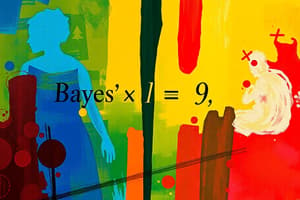Podcast
Questions and Answers
What is the formula used to compute the probability of the union of three events E1, E2, and E3?
What is the formula used to compute the probability of the union of three events E1, E2, and E3?
- P(E1 | E2) + P(E2 | E3)
- P(E1 ∩ E2 ∩ E3)
- P(E1) + P(E2) + P(E3)
- P(E1) + P(E2) + P(E3) - P(E1 ∩ E2) - P(E1 ∩ E3) - P(E2 ∩ E3) (correct)
How does the multiplication rule apply to independent events?
How does the multiplication rule apply to independent events?
- P(A ∩ B) = P(A) + P(B)
- P(A ∩ B) = P(A) * P(B) (correct)
- P(A ∩ B) = P(A) / P(B)
- P(A ∩ B) = P(A | B) + P(B | A)
What does the probability mass function (pmf) of a discrete random variable provide?
What does the probability mass function (pmf) of a discrete random variable provide?
- The cumulative probabilities of outcomes
- A continuous distribution of outcomes
- A method for deriving variances directly
- The probabilities of each outcome being observed (correct)
How can you derive the pmf from the cumulative distribution function (cdf)?
How can you derive the pmf from the cumulative distribution function (cdf)?
Which of the following represents the expected value of a discrete random variable X multiplied by a constant a and added to a constant b?
Which of the following represents the expected value of a discrete random variable X multiplied by a constant a and added to a constant b?
What is the complement rule according to the probability function?
What is the complement rule according to the probability function?
Which formula represents the addition rule for two events A and B?
Which formula represents the addition rule for two events A and B?
What does the domination principle state regarding probabilities?
What does the domination principle state regarding probabilities?
What is the law of total probability used for?
What is the law of total probability used for?
Which statement correctly describes independent events A and B?
Which statement correctly describes independent events A and B?
What is the inclusion-exclusion rule for three events A1, A2, and A3?
What is the inclusion-exclusion rule for three events A1, A2, and A3?
What is the difference rule for probability functions?
What is the difference rule for probability functions?
When proving Bayes' Formula, which principle is fundamentally employed?
When proving Bayes' Formula, which principle is fundamentally employed?
Flashcards are hidden until you start studying
Study Notes
ST259 Test I Information
- Date: October 11, 2024
- Time: 4:00 p.m.
- Location: LH3094
- Duration: 75 minutes
- Aids Allowed: Non-programming calculators and a formula sheet provided on the test paper.
- Content: Material from Parts 1, 2, and 3 of Lecture Notes
- Test Structure:
- Theoretical Questions (20%-25%):
- Properties of the probability function:
- Complement rule
- Domination principle
- Addition rule
- Inclusion-exclusion rule
- Difference rule
- Properties of the conditional probability function:
- Complement rule
- Domination principle
- General multiplication rule
- Law of total probability and Bayes' Formula
- Independence of events
- Fundamental probability formula for discrete random variables
- Properties of the probability function:
- Practical Questions (75%-80%):
- Sample space and events
- Classical probability
- Conditional probability
- Independence of events
- PMF and CDF of discrete random variables
- Mathematical expectation of discrete random variables
- Theoretical Questions (20%-25%):
- Additional Notes:
- Review lecture notes, WeBWorK and lab assignments, and recommended homework problems for a comprehensive set of examples.
Useful Formulae
-
Inclusion-Exclusion Rule for Three Events:
- P(A1 ∪ A2 ∪ A3) = P(A1) + P(A2) + P(A3) − P(A1 A2) − P(A1 A3) − P(A2 A3) + P(A1 A2 A3)
-
Multiplication Rule for Independent Events:
- P(A1 ∩ A2 ∩ · · · ∩ An) = P(A1) · P(A2) · P(A3) · · · P(An)
-
Bayes’ Formula:
- P(Bk | A) = P(A | Bk)P(Bk) / (P(A | B1)P(B1) + · · · + P(A | Bn)P(Bn))
-
Binomial Coefficient:
- nCk,n = n! / (k!(n − k)!)
-
Fundamental Probability Formula for Discrete Random Variables:
- P(X ∈ A) = Σx∈A∩D p(x)
Studying That Suits You
Use AI to generate personalized quizzes and flashcards to suit your learning preferences.




